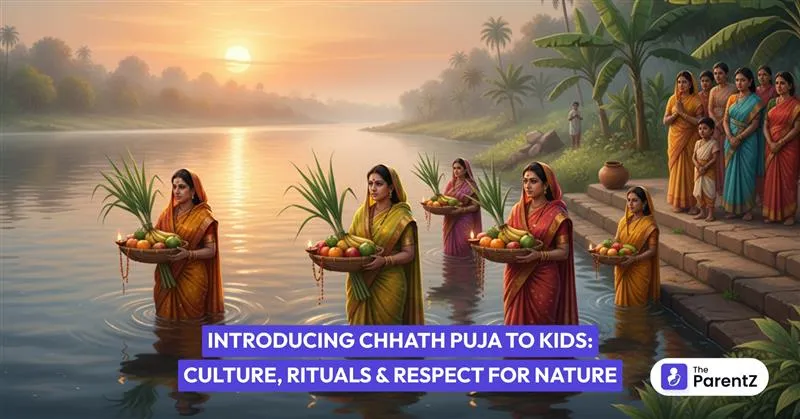Have you ever watched the sunrise or sunset and felt a warm glow inside your heart? That’s exactly what millions of families in Bihar and eastern Uttar Pradesh celebrate each year during Chhath Puja. This festival connects humans, nature, and faith in the most beautiful way.
Even if your family doesn’t celebrate Chhath, it’s worth telling the kids about it. After all, festivals aren’t just about rituals; they’re about stories, emotions, and gratitude. And Chhath Puja is one of those festivals that quietly teaches us respect for nature, discipline, and the power of togetherness.
The Heart of Chhath Puja
Chhath is one of India’s oldest festivals, dedicated to the Sun God (Surya) and Chhathi Maiya, believed to be the sister of the Sun. It usually happens in October-November, just after Diwali, when the air is crisp and the rivers sparkle in the early winter light.
What makes Chhath truly special is that it’s the only festival where people worship both the setting and rising sun. Isn’t that beautiful? It reminds us that both beginnings and endings deserve gratitude.
A Four-Day Journey of Faith and Simplicity
Chhath Puja isn’t about loud decorations or endless sweets. It’s celebrated with simplicity, cleanliness, and heartfelt devotion. The festival takes place over four days, each filled with meaningful rituals that even children can understand and enjoy learning about.
Day 1 – Nahaay Khaay (The Clean Start)
On this day, devotees take a dip in a river or any clean water body. Many bring holy water from the Ganga back home to use in rituals. Houses are cleaned spotlessly, symbolizing purity inside and out. You can tell your kids that it’s like giving your home and body a fresh start before saying thanks to nature.
Day 2 – Kharna (A Day of Fasting and Gratitude)
This day is all about self-control and gratitude. Devotees fast the whole day and break it in the evening with a simple meal of kheer (gur ke kheer) and fruits. Families come together to share the food, and there’s a peaceful sense of joy everywhere. Kids can relate to the idea of saying “thank you” to Mother Earth and showing patience before enjoying a treat.
Day 3 – Sandhya Arghya (Evening Offering to the Setting Sun)
This is the most magical part! Families gather at riverbanks dressed in traditional clothes, carrying bamboo baskets filled with fruits, sugarcane, and the special prasad. As the sun begins to set, everyone stands in the water and offers Arghya, a prayer with folded hands and offerings. The sight of hundreds of diyas glowing over the water is something every child should experience once. It’s a visual prayer that says, “Thank you, Sun, for your warmth and life.”
Later in the evening, there’s a local celebration called Kosi, where families make a small canopy using sugarcane sticks and decorate it with earthen lamps. The gentle flicker of the lamps, children’s laughter, and folk songs make the night unforgettable.
Day 4 – Usha Arghya (Morning Offering to the Rising Sun)
Before dawn, families return to the riverbank for the final offering, to the rising sun. Everyone waits patiently for the first golden ray to touch the water, and when it does, there’s a deep sense of peace. After the ritual, devotees break their fast with the prasad and share it with neighbors and relatives. It’s a day full of joy, relief, and blessings.
Teaching the Spirit of Chhath to Kids
If you’re a parent, Chhath Puja offers the perfect opportunity to spark meaningful conversations with your kids. Here’s how you can bring its spirit into your home:
- Storytime around the Sun: Tell your children how people across cultures have always worshipped the Sun. From Egyptians to Native Americans, the Sun has been a universal symbol of life.
- Nature Connection: Explain how Chhath teaches us to respect rivers, soil, plants, and sunlight. The rituals show that our existence depends on nature’s balance.
- Simple Living, High Thinking: The festival involves strict fasting, no fancy food, or extravagant celebrations. It’s a reminder that joy and peace can come from pure intentions.
- Family Bonding: You can involve kids in small rituals like cleaning together, lighting diyas, singing folk songs, or simply watching the sunrise together. These moments create strong emotional memories.
A Festival that Teaches Respect
In a world where festivals often get lost in lights and loud music, Chhath remains a symbol of quiet strength and discipline. It’s about patience, gratitude, and balance; the very values that help children grow into kind and grounded individuals.
When you talk about festivals like Chhath, you’re not just teaching culture; you’re passing down empathy. Kids learn that saying thank you to nature, showing care for rivers, avoiding waste, and being patient are real-life ways to practice spirituality.
Bringing Chhath Home
Even if you don’t live in Bihar or UP, you can bring the Chhath spirit home in small, family-friendly ways:
- Watch a video of Chhath celebrations and talk about what the kids observe.
- Draw or paint a sunrise together with your children.
- Light a diya in the evening and say a small prayer of gratitude for sunlight, water, and food.
- Cook simple prasad like kheer or fruits and explain their symbolic meaning.
These small acts make children feel part of a larger cultural story, one rooted in respect, love, and nature.
Conclusion
Chhath Puja is not just about worship. It’s a celebration of the earth, the sky, and the light that keeps us alive. Introducing it to kids is a beautiful way of reminding them, and ourselves, that sometimes the simplest traditions hold the deepest wisdom.








Be the first one to comment on this story.